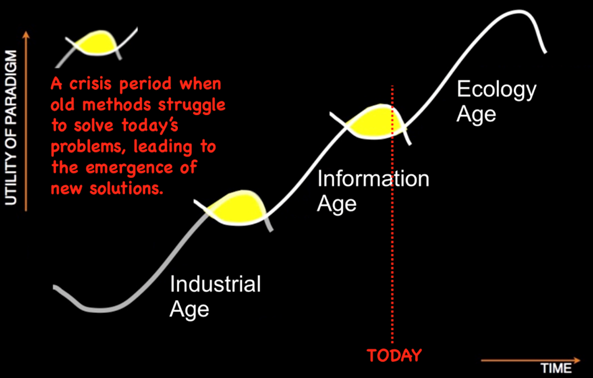
Radical Innovation in Mining Management
Social license, Digital transformation, Safety, and Profitability - four issues that seem to be caught in a perpetual trade-off. Spend more time on one, and it reduces the attention given to the others. It's a problem that impacts everyone in the organisation:
- As an executive, you're frustrated with events that unexpectedly emerge to disrupt production.
- As a manager, you're angry when corporate performance statistics don't reflect the tireless effort required to keep things running locally.
- As a supervisor, you're frustrated with fault finding in people and blaming individuals for mediocre results that are beyond their control.
- As an engineer, you're disillusioned by past innovative programs that started with a bang and then either withered away or had the budget pulled.
- As a tradesperson, you can sense worsening mine conditions but feel powerless in voicing your concerns.
Have we reached a plateau in our ability to improve on each of these issues individually as well as collectively? Peter Senge claimed: "Today's problems come from yesterday's solutions". In this first article, we introduce how yesterday's solutions have led to three myths that control current mining thinking. In the following months, we will delve deeper into each myth and the problems they create today.
Based on 15 years of consulting experience we believe that radical innovation is essential to disrupt myth domination. "Radical" does not necessarily mean painful and agonising. It means being enlightened that the world has radically changed and the Mining industry needs to catch up.
Three myths that destroy mining innovation
Myth 1: The best way to run a mine is to focus on cost certainty and manage people as if they are parts of a machine.
Myth 2: Mine operations should be optimised from start to finish to produce the best results.
Myth 3: We can achieve social licence acceptance and safety aims within our current management paradigm by pursuing effective culture change.
Each myth began as a solution for a specific era of time. Besides introducing new thinking, an Age carries the best of the previous ages forward while dispensing myths and fallacies with facts and evidence.
The evolution and implications of different Ages
The Industrial and Information Ages
The Industrial Age growth mindset in the early 20th century was fuelled by Scientific Management principles of productivity. The work environment was stable, certain, and predictable. However, it couldn't last forever when humans revolted over their treatment as mere cogs in a machine. A crisis point was reached resulting in declines in capital, labour, and material productivity.
Systems thinking and Human Factors boosted by computer technology offered new and improved alternatives. A popular solution called Business Process Reengineering succinctly captures the dominant engineering paradigm. This is the Information Age with people, process, and technology as parts of a system. “The whole is equal to the sum of its parts.” Industry rally behind "Faster, better, cheaper" in the pursuit of optimised efficiency. However, all is not well. We observe promising Information Age digital tools yielding negative impacts and making operations extremely complicated. As consultants, we have seen many attempts to optimise across the entire system to achieve efficiency. Some software packages are coded on this premise. However, systems thinkers like Russell Ackoff argue that system capability decreases. Eli Goldratt in his Theory of Constraints mathematically supports Ackoff's claim.

Figure 1: The development of the Industrial, Information and Ecological Ages.
Implementation of new technologies has not been easy. In 2016 strategic business & technology advisor and internationally best-selling author Bernard Marr wrote in Forbes.com that 25% of technology projects fail outright; 20-25% don't show any Return on Investment, and 50% need massive re-working by the time they're finished. From his experience, many projects failed not due to tech problems. In fact, 54 % of IT project failures were attributed to poor management.
Change Management programs are often deployed as the lever to execute implementation because they focus on changing culture. The belief is cause & effect relationships will apply to people as they do for mechanistic processes and technologies. Great, if valid. However, consulting firms (McKinsey, Connor, Kotter) have reported a dismal 70% failure rate of change management programs. Once again we’ve reached a crisis period and the decline of an Age.
The Ecological Age
In the Ecology Age, confusing dilemmas, ambiguous paradoxes, diverse conflicts are natural occurrences. Mining has become a complex adaptive system. The unexpected emergence of new things means “the whole is greater than the sum of its parts”. For example, when “hot water is poured over dry coffee grinds, aroma as a new thing emerges”. The interaction of two ingredients creates something new. A deeper example happens inside our heads. "Billions of neurons in our brain interact in ways that we cannot fully understand to create a stream of consciousness.” People are no longer viewed as predictable cause & effect machines but are illogical, emotional decision makers. Culture is not a lever but emerges as an outcome of people, process, and technology interacting.
The evolution of Safety through the Ages
Safety has gone through similar paradigm changes. In the Industrial Age, safety was defined as the absence of negative events. Humans are error prone, focus on what goes wrong, and the ideal target is zero harm. The term “Safety-I” was coined by Erik Hollnagel to describe this thinking, one which many organisations still follow.
In the Information Age, new schools of safety sprung to life. One posed humans as problems in a system that could be managed using safety policies, standards, rules and compliance inspections. In the “Safety-II” view, humans are solutions, able to adapt performance due to varying conditions in the work environment.
In the Ecology Age, we accept it’s human nature to be fallible; mistakes will be made. Less emphasis is given to changing the behaviours of illogical, emotional decision-makers. Instead, emphasis is placed on influencing relationships and interactions and designing systems for imperfect humans. Like culture, safety is an emergent property of a complex adaptive system. Workers don’t create safety. They create the conditions that enable safety to emerge; they can also create the conditions that enable danger to emerge.
Social Licence as an Ecological problem
We can add Social Licence to Operate as another emergent property of a complex adaptive system. SLO involves not just the community in which the mine is situated, it also involves employees, government (through regulation) and societal attitudes at large. In our conversations with mining managers, we hear the lament they cannot free up the time to deal with ecological issues. They are also aware in the Ecology Age the Internet with fast feedback loops empowers people to socially connect and voice their concerns. Failure to place sufficient attention may lead to a tense issue “going viral”. What do we do?
Dealing with Ecological problems
We need to create the conditions where we are able to free up time and high-level manpower to embark on new ways of doing to deal with these ecological issues. To do this we need to understand the myths holding us back, to stop doing much of what is considered best practice and start doing differently. Management’s role in this endeavour is critical.
Based on 15 years of experience and more than 85 mining interventions we believe this is possible.
We look forward to offering our Information and Ecology Age ideas and thoughts in the series of upcoming articles. We shall put Einstein's quote to the challenge: “We cannot solve our problems at the level of thinking that caused them in the first place.”
Should you wish to share some thoughts, please contact Hendrik Lourens at [email protected].
Written by:
Gary Wong and Hendrik Lourens - Stratflow
Websites: Stratflow and Miningdifferently